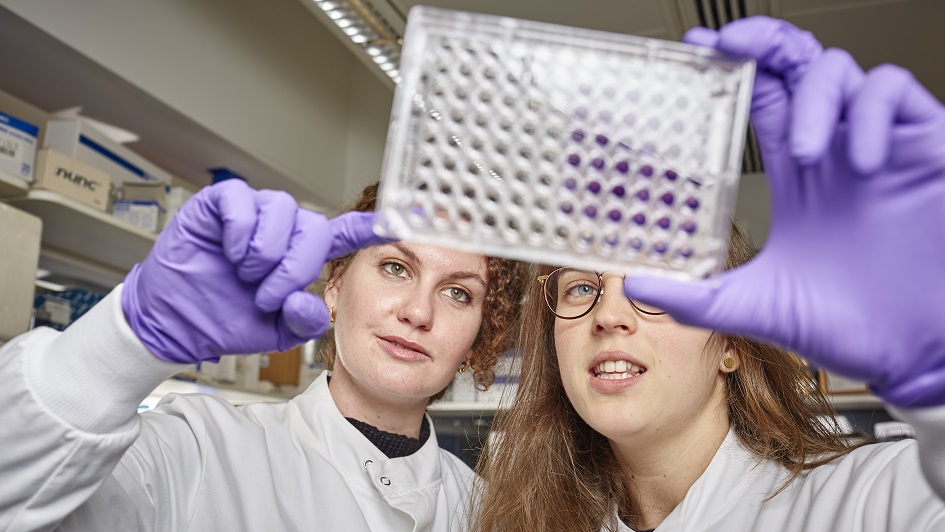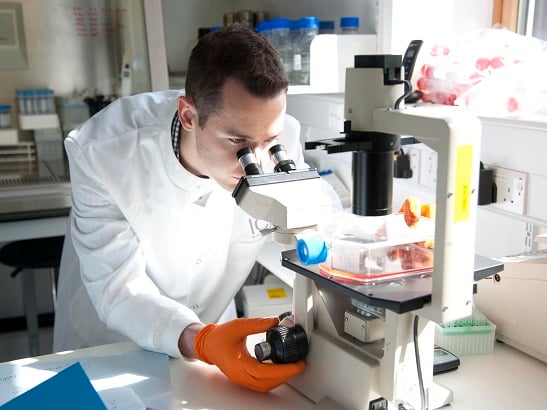
Frequently overshadowed by clinical research, discovery science in the laboratory might sometimes seem to be hidden behind the scenes. But this research is crucial in the fight against cancer and at The Institute of Cancer Research we are determined to shine a spotlight upon discovery science.
Cancer discovery science is research that aims to transform our fundamental understanding of cancer biology. It is sometimes called basic or fundamental science (although it’s usually very complicated!). Discovery science investigates a huge range of topics within cancer biology – ranging from the process involved in the regulation of cell division to how cancer can evolve and adapt, from the immune system’s interactions with cancer cells to the role of chemical signal networks in cancerous cell growth.
Discovery science is often done on cells or in model systems, such as yeast, fruit flies, nematode worms and mice, where scientists try to recreate the cancers found in the human body. It also includes computational science which uses mathematical models to analyse and answer scientific questions.
Conclusions from discovery science can then, with further research, be used to translate the findings into results that directly benefit people: a process often described as going from bench to bedside.
Although their work is some way off from the clinic, discovery scientists at the ICR are determined to choose areas of research that have the potential to ultimately benefit patients. They focus on finding clues from fundamental cancer biology that might lead to the development of promising, innovative new cancer treatments.
The ICR has hundreds of discovery science researchers, I spoke to some of them about their work and why they think discovery science deserves to be celebrated.
“Every drug discovery can be traced to discovery research”
Professor Jon Pines is Head of the Division of Cancer Biology at the ICR. As a PhD student Professor Pines worked in the lab of Nobel Prize laureate Sir Tim Hunt at the University of Cambridge. Jon contributed to the discovery science research on cyclins (proteins involved in the control of cell division cycles) in sea urchin eggs which earned Hunt the 2001 Nobel Prize in Physiology or Medicine alongside Sir Paul Nurse and Leland H. Hartwell.
“There is nothing quite like discovering the answer to something in science and a brief moment realising that you are the only person in the world who knows it.” Professor Pines says. “I had that feeling when I cloned and sequenced ‘cyclin’ in Tim’s lab.”
The discovery that cyclins are key regulators of cell growth and division allowed cancer researchers to explore whether the inhibition of protein complexes containing cyclins, called cyclin-dependent kinases (CDKs), might have potential as a cancer treatment. One of these CDK inhibitors, palbociclib, is now a common treatment for some types of breast cancer.
“Without the discovery science done by Tim Hunt and others we wouldn’t have palbociclib. The origins of every drug discovery can be traced to discovery research and that, for me, is the reason that we should be celebrating discovery science.”
Pieces of a puzzle
It might be hard to see how studying animals like sea urchins can tell us anything about cancers in humans. I asked Dr Lucas Dent, Postdoctoral Training Fellow in the Dynamical Cell Systems Lab at the ICR, about the importance of cell and animal models in discovery science.
“One way to understand the intricate mechanisms going on within and between cells is to first look at cells isolated in the lab and simple life forms.” Dr Dent explained, “These model organisms have very similar basic biology to humans and can provide clues to how cancer works in humans. It is also possible to genetically modify a lot of model organisms to investigate the role of certain genes and proteins.”
“In our lab we genetically modify fruit flies, as well as using computational methods, and human cells, to understand more about how complex biochemical signalling networks are ‘rewired’ during the development of cancer.”
He continued, “However, it’s important to be clear that findings in discovery science are a starting point in the process, when considering future patient benefit. Cells can behave differently when isolated in the lab and within animals that are not closely related to humans. So, discovery science findings should be viewed as pieces of a puzzle, it takes a lot of puzzle pieces coming together before we see the picture.”
Characterising the BRAF gene
Another great example of discovery science leading to a vital new treatment for patients is the work by ICR scientists on characterising the BRAF gene and its role in cancer.
In the early 1990s, a team of ICR researchers led by Professor Chris Marshall began studying a cell signalling pathway involved in the control of cell growth. Their research looked at the role of the pathway – known as the RAS/RAF/MEK pathway – in cancer. Further work by the team suggested that a protein called BRAF might contribute to cancer development.
The researchers then went on to confirm mutated BRAF as an oncogene capable of driving the development of cancer even in the absence of other major genetic defects.
These findings from discovery science research helped pharmaceutical companies discover cancer drugs which act by inhibiting the mutated BRAF protein. These selective inhibitors of mutated BRAF include dabrafenib which has been approved to treat melanoma skin cancer.
Tracing discoveries from the lab through to benefiting patients
Professor Jon Pines, who has the title of the Chris Marshall Chair of Cell Biology at the ICR, spoke to me about this work. “Chris worked at the ICR for 35 years, he was an extremely insightful and rigorous scientist. It’s fantastic to be able to trace his discovery in the lab and see it go all the way to the point where it has a positive effect on the lives of patients.
Professor Pines continued, “There are few organisations where you can see the research go from lab bench to patient bedside as you do at ICR, and that’s pretty special.”
Dabrafenib was discovered by a GlaxoSmithKline team which included Dr Olivia Rossanese – who is now Head of the Division of Cancer Therapeutics and Director of the Cancer Therapeutics Unit at the ICR. Dr Rossanese agrees that discovery science is essential to drug discovery and development.
“What’s really important for us is to understand the underlying mechanisms and genetic alterations in cancer that lead to uncontrolled tumour growth and spread.” she explains, “And when we begin to understand those mechanisms, we really have a good idea of what the targets are for therapeutics.”
The discovery science research into the RAS/RAF/MEK pathway by Professor Marshall and others at the ICR also led to identification of the mechanism by which mutated RAS proteins cause cells to become cancerous.
The team showed that the RAS protein activates an important signalling pathway in cells called the MAP kinase pathway. In cancer cells with a mutated RAS the MAP kinase pathway is always switched on and drives cancers to grow.
Further research found that two molecules, RAF and MEK, transmit signals from RAS to MAP kinase and are essential to cancer growth. RAF and MEK are excellent drug targets and translational research based on the ICR’s fundamental science led to the discovery of the MEK inhibitor trametinib. Trametinib is now licensed for use and regularly used alongside dabrafenib to treat melanoma.
“Look how far we’ve come”
Someone who has directly benefited from the science at the ICR which led to the discovery of dabrafenib and trametinib is patient advocate Debbie Keynes.
Debbie was diagnosed with advanced melanoma in April 2016 and was treated with dabrafenib and trametinib for a number of years.
We spoke to Debbie in 2018 and she told us about her experience of being diagnosed with melanoma and her treatment with dabrafenib and trametinib.
A fundamental part of the work we do
At the ICR we are extremely proud of our discovery science research. I spoke to the Chief Executive and President of the ICR, Professor Kristian Helin, about why this part of our research is so key.
“Take the Covid-19 vaccines for example, what most people don’t realise is that there will have been at least 25 years of discovery research in labs which enabled the vaccines to be developed and taken to clinical trials so quickly. Without discovery science we would not have vaccines, it’s that simple.
“For cancer it’s the same – there would be no new drugs if it wasn’t for discovery science. It’s an absolutely fundamental part of the work we do at the ICR.”
